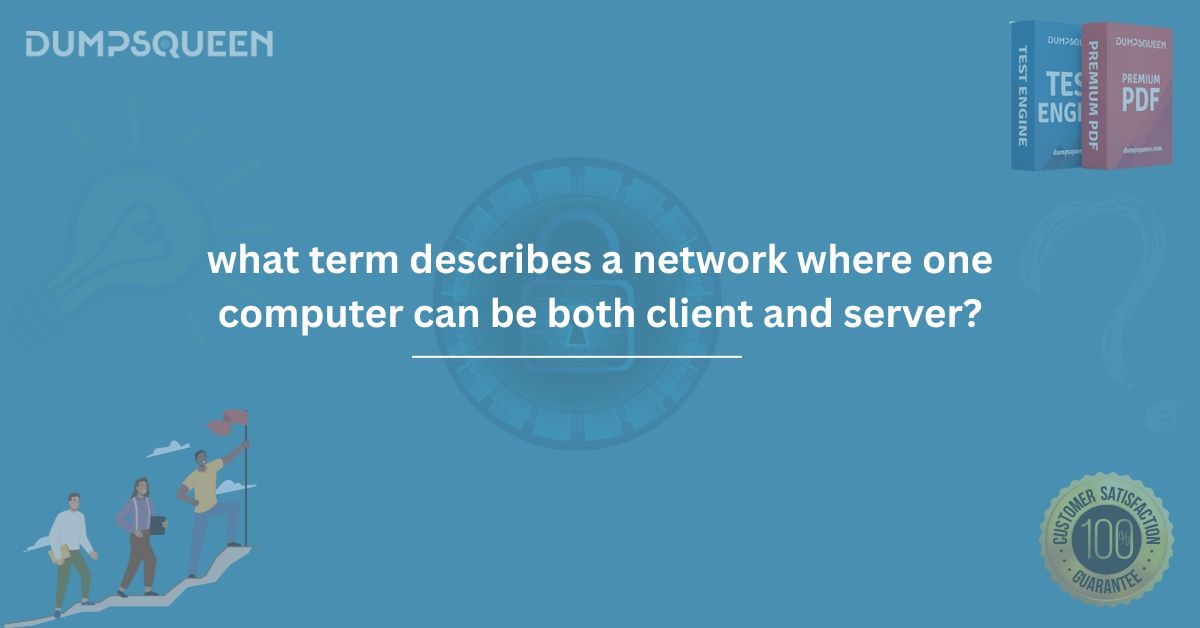Introduction
In the world of networking, various architectures define how devices interact and communicate with each other. One such network model allows a single computer to function as both a client and a server. This model plays a crucial role in modern computing, offering flexibility and efficiency in resource sharing. Understanding this concept is essential for IT professionals, students, and tech enthusiasts. DumpsQueen provides an in-depth exploration of this networking model to enhance your knowledge and clarify any doubts regarding this topic.
Understanding the Client-Server Relationship
Before delving into the term that describes a network where one computer acts as both a client and a server, it is essential to understand the basic client-server model. In traditional networking, a client is a device that requests resources or services, while a server is a device that provides those resources or services. These interactions form the backbone of network communication, from web browsing to database access.
The Peer-to-Peer (P2P) Network Model
The term that describes a network where one computer can function as both a client and a server is the Peer-to-Peer (P2P) network model. In a P2P network, each device, or "peer," can act as both a provider and consumer of resources. This decentralized approach contrasts with the traditional client-server architecture, where dedicated servers handle requests from clients.
How Peer-to-Peer Networks Work
In a P2P network, computers communicate directly with each other, sharing resources such as files, processing power, and internet bandwidth. Unlike traditional client-server networks, there is no central authority managing the communication. Instead, each device can initiate and fulfill requests, making the network more resilient and scalable.
Advantages of a Peer-to-Peer Network
Peer-to-peer networks offer several benefits, making them popular for various applications. Some of the key advantages include:
-
Decentralization: Since there is no central server, the network remains operational even if some devices go offline.
-
Cost-effectiveness: No expensive server infrastructure is required, reducing the cost of implementation.
-
Scalability: P2P networks can expand easily as more devices join the network.
-
Efficient Resource Utilization: Each device contributes to the overall functionality, balancing the load more effectively.
Disadvantages of a Peer-to-Peer Network
Despite its advantages, the P2P model also comes with some drawbacks:
-
Security Risks: Without a central authority, monitoring and securing the network can be challenging.
-
Performance Variability: The speed and efficiency of the network depend on the capabilities of individual devices.
-
Data Management Complexity: Synchronizing and managing shared resources across multiple devices can be difficult.
Applications of Peer-to-Peer Networks
Peer-to-peer networking is used in various domains, including:
-
File Sharing: Platforms like BitTorrent use P2P networks to distribute files efficiently.
-
Cryptocurrency: Bitcoin and other decentralized digital currencies rely on P2P networking.
-
Online Gaming: Some multiplayer games use P2P connections to reduce server dependency.
-
Communication Services: Applications like Skype previously utilized P2P technology for voice and video calls.
Peer-to-Peer vs. Client-Server: A Comparative Analysis
| Feature | Peer-to-Peer (P2P) | Client-Server |
|---|---|---|
| Centralization | Decentralized | Centralized |
| Cost | Low | High |
| Scalability | High | Limited |
| Security | Moderate | Higher |
| Performance | Variable | Consistent |
Understanding these differences helps businesses and individuals choose the right network model based on their requirements.
Free Sample Questions
-
Which term describes a network where one computer can act as both a client and a server?
-
A) Client-Server
-
B) Peer-to-Peer
-
C) Cloud Computing
-
D) Virtual Private Network
Answer: B) Peer-to-Peer
-
-
What is one key advantage of a peer-to-peer network?
-
A) Centralized control
-
B) Reduced dependency on a single server
-
C) High implementation costs
-
D) Requires dedicated server hardware
Answer: B) Reduced dependency on a single server
-
-
Which of the following is NOT a disadvantage of a P2P network?
-
A) Security risks
-
B) High maintenance costs
-
C) Performance variability
-
D) Data management complexity
Answer: B) High maintenance costs
-
-
Which of the following applications commonly use P2P networking?
-
A) File sharing platforms
-
B) Cloud storage services
-
C) Centralized databases
-
D) Traditional web hosting
Answer: A) File sharing platforms
-
Conclusion
Understanding network models is crucial for optimizing resource sharing and communication in the digital world. The Peer-to-Peer (P2P) network model allows devices to function as both clients and servers, offering scalability and cost-effectiveness while presenting unique security and management challenges. DumpsQueen provides a comprehensive overview of such networking concepts to enhance your knowledge and help you stay ahead in the field of IT and networking.



